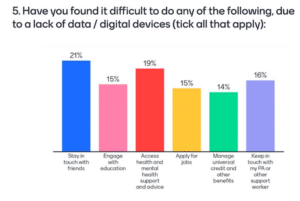Digital Inclusion Action Plan: NLCBF Response

Our Key Asks for care experienced young people aged 18-25:
- A national offer of free WiFi – This is a key ask from Young People’s Benchmarking Forum ‘In Their Own Words: Communities of Support’ report.
- A national offer around access to digital devices, that are easy to access and appropriate for the young people’s needs.
- This offer must be easy to access and well publicised, including being outlined in each Local Authority’s local offer for care leavers.
Why should the Digital Inclusion Strategy consider care-experienced young people?
Care experienced young people are particularly at risk of digital exclusion due to:
- Cost of Living Pressures – Care experienced young people are financially independent from the age of 18, often far earlier than their peers. In our recent Cost of Living survey of over 200 care experienced individuals, 77% reported to buy food at least some of the time & 38% had placed themselves in a vulnerable position to afford essentials.
- Not having access to the ‘family home WiFi’ – The majority of care experienced young people live independently far earlier than non-care experienced peers , who leave home at the age of 24 on average – where WiFi is often provided in the family home at no cost to the young person. Care experienced young people are often managing the costs of running a home while still pursuing education, working in an entry level job or accessing the under 25 rate of Universal Credit.
- ‘Postcode Lottery’ of support from Local Authority leaving care teams around digital devices and WiFi – With significant financial pressures on Local Authorities, support with digital devices is often limited to those who are in education. Provision of support with WiFi is available in some local authorities but this is often limited to a year.
Statistics from Catch22’s employability projects show that of the 621 care experienced young people they have worked with over the last 4 years:
- 48% of participant did not have access to WiFi when joining the employability programme
- 62% of participants did not have, or have access to, a working laptop when they joined the programme
What impact does digital exclusion have on care experienced young people?
Digital exclusion creates additional barriers for care experienced young people in accessing services and support; applying for jobs and staying connected with friends and family – Care experienced young people are already at high risk of isolation with just 12% of those surveyed in our Communities of Support Report saying they felt ‘very connected’ to their community.
In a January 2021, in a survey focused on Digital Access, Young People’s Benchmarking Forum members reported that lack of data and devices made it difficult for:
- 21% to stay in touch with friends
- 15% to engage with education
- 19% to access health & mental health support and advice
- 15% to apply for jobs
- 14% to manage universal credit and other jobs
- 16% to keep in touch with their Personal Adviser or other support workers

This demonstrates how many areas of life are impacted by digital exclusion. This survey was taken during the pandemic, when there was additional support with access to WiFi & devices and additional financial support to those on Universal Credit. Care experienced young people today, are in a poorer financial position than when this survey was conducted.
What would make a difference?
- A national offer of free WiFi – This is a key ask from Young People’s Benchmarking Forum in our ‘Communities of Support’ report. This would enable connection with family, friends, support services, applying for jobs etc. This would reflect what a good parent would provide for their child and support the government’s introduction of corporate parenting duty to government departments & public bodies in the Children’s Wellbeing Bill. This must be a generous data allowance – Over half of the care experienced young people who received support with data during Covid told us they received less than 2MB for the month, which was insufficient and ran out very quickly.
- A national offer around access to digital devices, that are easy to access and appropriate for the young people’s needs – These could be distributed by Local Authority leaving care teams. We must learn from the digital device offer for care experienced young people during Covid:
- Many were unusable due to the firewalls installed – Where devices are recycled, firewalls need to be removed or made appropriate for a young person’s use.
- There was confusion about the delivery and availability & who to speak to in case of an issue. In a survey of local authorities during the Keep Care Leavers Connected Campaign covering more than 6000 care leavers between them, 40% said that none of the care leavers they worked with had received a laptop or tablet as part of the Government-funded scheme. This was due to a variety of issues, including IT problems, distribution delays and confusion over eligibility criteria.
- This offer must be easy to access and well publicised, including being outlined in each Local Authority’s local offer for care leavers – This offer should be publicised via the Care Leaver Covenant and through each Local Authority’s local offer – to ensure that every young person leaving care knows their eligibility and how to access the offer. Accessing this digital offer is key to breaking down the barriers for care experienced young people & we must ensure we monitor the take up, to identify areas or groups of care experienced young people who are not accessing the offer.
Read our full response here
You can read the government’s Digital Inclusion Action Plan Here. Please do share our Key Asks with local and national decision makers.